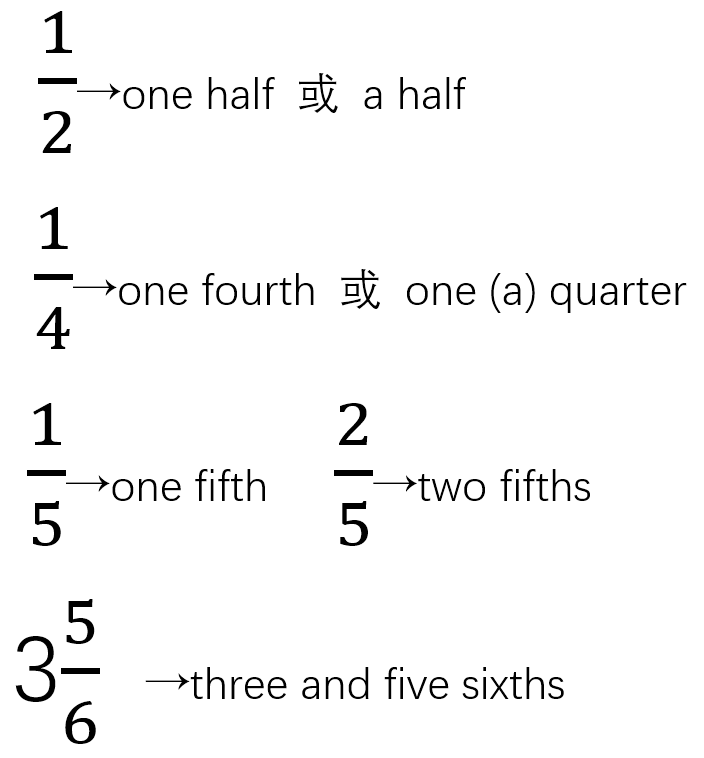第三讲:数词
一. 数词的概念(什么是数词?)
数词是表示人或事物的数目或顺序的词。
二. 数词的分类
基数词和序数词
基数词表示数目的多少;
序数词表示数目的顺序,其前通常加定冠词the。
三. 基数词的构成
(1) 1-12为独立的单数。
如:one, two, three, four, five, six, seven, eight, nine, ten, eleven, twelve
(2) 13~19的基数词以-teen结尾。
如:thirteen, fourteen, fifteen, sixteen, seventeen, eighteen, nineteen
(3) 20~90整十位的基数词以-ty结尾。
如:twenty, thirty, forty, fifty, sixty, seventy, eighty, ninety。
(4) “几十几”由十位数和个位数之间加连字符“-”构成。
如:36→thirty-six;58→fifty-eight;
(5) 101~999的基数词由百位数后加and,再加十位数或个位数构成。
如:108 →one hundred and eight
365→three hundred and sixty-five
(6)1000以上基数词的表示方法:从右向左用分节号“,”分节,每三个数字为一节,第一个分节号前用thousand,第二个分节号前用million。
如:37, 000→thirty-seven thousand
689,000,000→six hundred and eighty-nine million
注意:hundred, thousand, million等用在具体的数字后面时用单数;
如:four hundred students四百学生
fifty thousand trees五万棵树
当thousand, million, billion等前面没有具体的数字时通常用复数,并与of连用,表示大致的数量。
如:
hundreds of 数百的;成百上千的;
thousands of 数千的;成千上万的;
millions of 数百万的
There are hundreds of students on the playground. 操场上有数百学生。
四. 序数词的构成
(1) 第一、第二、第三分别为first, second, third。
(2) 第四至十九都是由相应的基数词加-th构成。
如:fourth, seventh
第五、第八、第九和第十二的拼写有所变化。
five → fifth, eight → eighth, nine → ninth, twelve → twelfth。
(3) 整十位数的序数词由相应的基数词变y为i,再加上-eth构成。
如:twentieth, thirtieth, fortieth, fiftieth, sixtieth, seventieth, eightieth, ninetieth
(4) 第二十一至第九十九的序数词只需在个位数上采用序数词形式,十位、百位、千位以上的数字均用基数词表示。
如:
第二十一→twenty-first 第三十六→thirty-sixth
(5)第一百、第一千、第一百万分别在相应的基数词后面加上-th。
如:hundredth, thousandth, millionth
(6)序数词的缩写形式,由阿拉伯数字加序数词的后两个字母构成。
如:
第一→1st;第二→2nd;第四十五→45th;第一百零六→106th
五. 数词的其他形式
1.分数数
分数由基数词和序数词合成,分子用基数词,分母用序数词。若分子大于1时,分母用复数形式,即序数词加-s。带分数的读法为“整数+and+分数”。
如:

2. 小数
整数与小数之间用小数点隔开。读小数时,小数点后面的数字要单独读出。小数点读作point(点),零读作zero。如果整数是零,往往不读出。
如:
0.1→zero point one或point one
0.02→zero point zero two
2.25→two point two five
16.16→sixteen point one six
注意:
与小数连用的名词的数:整数是零时,名词用单数形式,其他情况名词用复数形式。
如:
0.47 metre → zero point four seven metre;
1.59.metres → one point five nine metres
3. 百分数
用percent表示。
如:3% → 3 percent,读作three percent
4. 时刻的表达法
①分钟数+时钟数
半小时以内用(含半小时)“分钟数+past+时钟数”,表示“几点过几分”;
超过半小时则用“分钟数+to+时钟数”,表示“差几分钟到几点”。
如:4:12→twelve past four;
7:46→fourteen to eight(差14分8点)
②时钟数+分钟数
如:5:30→five thirty;8:20 →eight twenty
5. 年、月、日的表达法
年份用基数词,两位一起读;日期用序数词。
如:1998年5月1日可以写作May 1(st), 1998
读作May the first, nineteen ninety-eight
也可写作1(st) May, 1998,读作the first of May, nineteen ninety-eight;
2012年7月6日 可以写作July 6, 2012
读作 July the sixth, two thousand and twelve(或twenty twelve)
也可全用阿拉伯数字表达,但要注意英美差异,英国先写日子,美国先写月份。
如:7, 6, 2012
=2012年6月7日(英国) ;=2012年7月6日(美国)
6. 编号及电话号码
① 用No. +基数词。
如:1号:No. 1;6路公共汽车:No.6 bus
② 用the+序数词+名词。
如:the fifth lesson 第五课;the first day 第一天
③ 用名词(首字母大写)+基数词(若用英语拼写,首字母要大写)。
如:第一课: Lesson One;四班 Class Four
电话号码在朗读时要一个数字一个数字的读。
如:89735182 读作 eight nine seven three five one eight two
如果有两个相同的数字时,也可用double(两个)来表示。
如:89735582 读作
eight nine seven three five five eight two或eight nine seven three double five eight two







